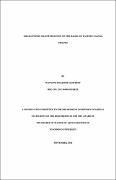| dc.description.abstract | This study set out to investigate and assess the Bagisu economic transformation between 1904 and 1962. Very little had been done on this aspect of Bagisu economic transformation, First, it is important to note that the Bagisu live in Eastern Uganda in Manafwa, Mbale, Bududa, Bulambuli and Sironko Districts. The Bagisu were chosen for this study because they constituted a large population in the former Bukedi district and had absorbed a good number of people from neighboring ethnic communities.
How the Bagisu transformed economically from 1904 to 1962, the force behind their transformation and the impacts of outside factors on Bagisu economic transformation constituted a problem that this study investigated. The main objective was therefore, to establish how the Bagisu of Eastern Uganda trans- formed economically from 1904 to 1962. Qualitative methodology was used in data collection and analysis. Instruments used included library, archival and oral interviews, mindful of reliability, validity and ethical concerns was observed. The study was carried out under development and under development theories postulated by Graven kitching and Walter Rodney who argued that man 's fundamental needs are materials.
Kitching argued that with the advent of colonialism there occurred introduction of new crops, new methods of agriculture and more opportunities for African agricultural goods to be sold abroad. To them this helped the African population to develop economically. It was established that indeed, the coming of British to Eastern Uganda accelerated the economic development of the Bagisu. It’s a fact because, new crops were introduced especially cotton and coffee, good methods of farming begun, money economy to avoid barter system was also in place, western Education which helped the Bagisu to improve in technologies was also introduced . It should be noted that the British used Baganda as agents in administering their rule in Eastern Uganda. Therefore, the role of Semei Kakungulu in the economic development was also established.
This study is significant as it contributes to the existing body of knowledge and widens the horizon of African history in general and Uganda's history in particular, as it expounds on how the Bagisu trans formed economically from 1904 to 1962. | en_US |

